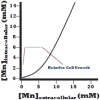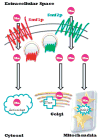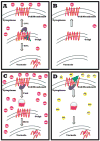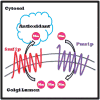Manganese homeostasis in Saccharomyces cerevisiae
- PMID: 19705825
- PMCID: PMC3010240
- DOI: 10.1021/cr900031u
Manganese homeostasis in Saccharomyces cerevisiae
Figures






Similar articles
-
The role of the Saccharomyces cerevisiae CCC1 gene in the homeostasis of manganese ions.Mol Microbiol. 1996 Aug;21(3):519-28. doi: 10.1111/j.1365-2958.1996.tb02561.x. Mol Microbiol. 1996. PMID: 8866476
-
Phosphate permeases of Saccharomyces cerevisiae: structure, function and regulation.Biochim Biophys Acta. 1999 Nov 16;1422(3):255-72. doi: 10.1016/s0304-4157(99)00010-6. Biochim Biophys Acta. 1999. PMID: 10548719 Review. No abstract available.
-
Manganese toxicity and Saccharomyces cerevisiae Mam3p, a member of the ACDP (ancient conserved domain protein) family.Biochem J. 2005 Mar 15;386(Pt 3):479-87. doi: 10.1042/BJ20041582. Biochem J. 2005. PMID: 15498024 Free PMC article.
-
Manganese transport and trafficking: lessons learned from Saccharomyces cerevisiae.Eukaryot Cell. 2005 Jul;4(7):1159-65. doi: 10.1128/EC.4.7.1159-1165.2005. Eukaryot Cell. 2005. PMID: 16002642 Free PMC article. Review. No abstract available.
-
Immunological evidence for the involvement of cell wall proteins in phosphate uptake in the yeast Saccharomyces cerevisiae.Arch Microbiol. 1986 Apr;144(3):207-12. doi: 10.1007/BF00410948. Arch Microbiol. 1986. PMID: 3524497
Cited by
-
Elemental economy: microbial strategies for optimizing growth in the face of nutrient limitation.Adv Microb Physiol. 2012;60:91-210. doi: 10.1016/B978-0-12-398264-3.00002-4. Adv Microb Physiol. 2012. PMID: 22633059 Free PMC article. Review.
-
Manganese-induced cellular disturbance in the baker's yeast, Saccharomyces cerevisiae with putative implications in neuronal dysfunction.Sci Rep. 2019 Apr 25;9(1):6563. doi: 10.1038/s41598-019-42907-2. Sci Rep. 2019. PMID: 31024033 Free PMC article.
-
Direct measurement of the Mn(II) hydration state in metal complexes and metalloproteins through 17O NMR line widths.J Am Chem Soc. 2013 Dec 11;135(49):18600-8. doi: 10.1021/ja4094132. Epub 2013 Oct 24. J Am Chem Soc. 2013. PMID: 24088013 Free PMC article.
-
High-resolution genome-wide scan of genes, gene-networks and cellular systems impacting the yeast ionome.BMC Genomics. 2012 Nov 14;13:623. doi: 10.1186/1471-2164-13-623. BMC Genomics. 2012. PMID: 23151179 Free PMC article.
-
Effect of metal ions on Alzheimer's disease.Brain Behav. 2022 Mar;12(3):e2527. doi: 10.1002/brb3.2527. Epub 2022 Feb 24. Brain Behav. 2022. PMID: 35212185 Free PMC article. Review.
References
-
- Keen CL, Ensunsa JL, Clegg MS. In: Metal ions in biological systems. Sigel A, Sigel H, editors. Vol. 37 Marcel Dekker; New York: 2000. - PubMed
-
- Wieghardt K. Angew Chem. 1989;101:1179.
-
- Sigel A, Sigel H, editors. Metal ions in biological systems. Vol. 37 Marcel Dekker; New York: 2000.
-
- Culotta VC. In: Metal ions in biological systems. Sigel A, Sigel H, editors. Vol. 37 Marcel Dekker; New York: 2000. - PubMed
-
- Luk E, Jensen LT, Culotta VC. J Biol Inorg Chem. 2003;8:803. - PubMed
Publication types
MeSH terms
Substances
Grants and funding
LinkOut - more resources
Full Text Sources
Molecular Biology Databases

